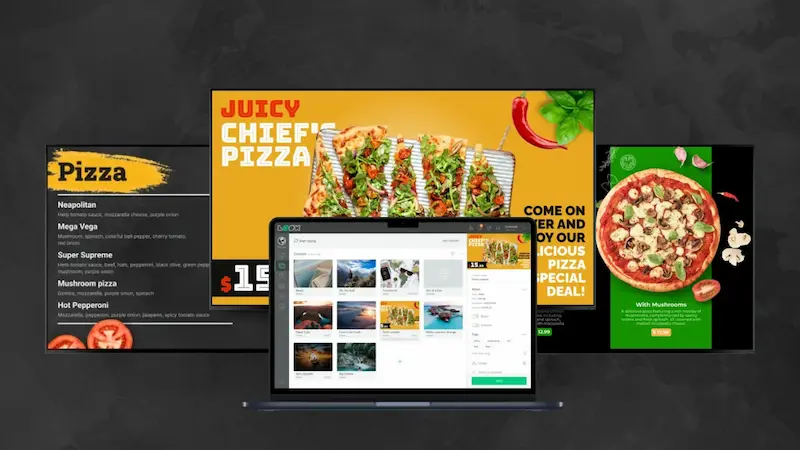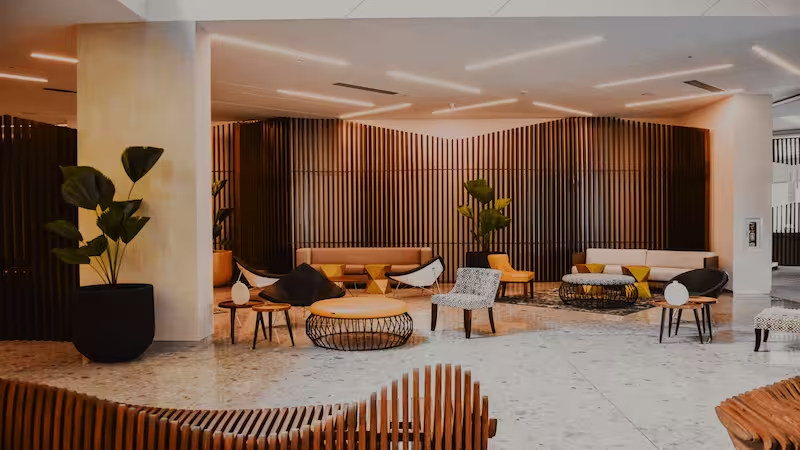
Table of Content
The Super Bowl, one of the biggest outdoor sports events typically attracts over 70, 000 attendees to the stadium. Imagine trying to keep that many people engaged and informed without extensive display technology. Jumbotrons are massive larger-than-life displays that bring the action right where the fans are and make the experience more memorable.
What is a Jumbotron?
A Jumbotron is a large, high-definition video screen used for arena digital signage in sports stadiums, concert venues, and other outdoor spaces to display live events, close-ups, video clips, and other visual content to the audience.
Although both are colossal displays, don’t confuse a Jumbotron with a video wall - they differ in overall purpose, technology, and application. A Jumbotron is typically a single massive screen meant for outdoor applications only.
A video wall on the other hand is composed of multiple smaller screens arranged in a grid-like fashion to create a seamless, high-resolution image for use in commercial, and public settings such as in corporate lobbies, conference rooms, retail stores, or public venues. They are more customizable in shape for those looking for a custom-tailored display solution.
History and Evolution of Jumbotrons
While Mitsubishi Electronics pioneered the first large-scale video display system under the brand name “Diamond Vision”, it was Sony that popularized the concept and coined the term Jumbotron which quickly became a generic name for large video screens.
One of the earliest installations was at the 1985 World’s Fair in Tsukuba, Japan. And for their time, it’s no surprise they had a low resolution of about 240 x 192 pixels, and used cathode ray tubes(CTRs) and thousands of small light bulbs to create images and videos. Regardless, they stood at 40 x 25 feet in size, which was revolutionary for the time.
The Jumbotron eventually transitioned from bulb-based displays to LEDs that provided brighter, more vibrant images with far greater energy efficiency. It also made it possible to create even larger screens with higher resolutions.
How Does a Jumbotron Work?
LED Panels: The most critical component of a Jumbotron is its LED panels. These panels are made up of thousands (or even millions) of tiny LEDs that emit light when an electric current passes through them. Each LED acts as a pixel, and when combined, they form the image that the audience sees. The arrangement and density of these LEDs determine the resolution of the screen.
Processing Units: To display content on a Jumbotron, video signals must be processed and sent to the LED panels. This is where processing units come into play. They receive video input from various sources, such as cameras, computers, or broadcast feeds, and convert them into a format that can be displayed on the LED panels. Advanced processing systems also allow for real-time video adjustments, such as color correction, scaling, and image enhancement.
Control System: As the brain of the Jumbotron, it manages the content that appears on the screen, including live video, advertisements, and informational displays. Operators can control the Jumbotron from a central console, to switch between different video feeds, adjust screen settings, and manage the overall display during an event.
Power Supply: Given their size and brightness, Jumbotrons require a substantial amount of power to operate. The power supply systems are designed to provide consistent energy to the LED panels and processing units so that the display remains bright and clear throughout the event.

Benefits of Using Digital Signage and Jumbotrons in Arenas
Enhanced Fan Experience
Fans at disadvantaged seat locations with obstructed views can still feel connected and engaged since Jumbotrons provide a wide viewing surface. They can catch close-ups of key moments and player reactions which ultimately lead to a more equitable fan experience.
Revenue Generation
Brands are ready to pay substantial ad money for the exposure they can get from large audiences in outdoor events. Event organizers can offer advertisers the option to run dynamic campaigns that respond to the game’s action, such as promotions triggered by a specific score or outcome. These are highly impactful ad placements that generate revenue from charging premium rates.
Real-Time Information
Real-time information displayed on Jumbotrons keeps fans in the loop and adds to the excitement. Live scores, stats, and replays make sure no one misses a thing even if they step away for a snack or restroom break.
Examples of Jumbotron Applications in Arenas & Stadiums

Madison Square Garden, New York City
One of the most iconic examples of modern Jumbotron technology can be found at Madison Square Garden in New York City. GardenVision includes more than 20 individually produced LED displays that provide fans with an immersive visual experience.
The central display, which is suspended above the arena floor, features 24 high-definition LED displays curved to mirror the circular design of the Garden.
The main video displays measure 4.8 meters tall by 8.5 meters wide, and they are capable of showing one continuous image around the board to highlight live video and instant replays.
Alternatively, the display can be divided into multiple sections to showcase vivid graphics, real-time statistics, scoring information, and promotional videos.
A unique feature of GardenVision is the inclusion of LED displays on the inside bottom of the board that provide real-time updates and game information to those seated in the lower sections.
AT&T Stadium, Arlington, Texas
Home to the Dallas Cowboys, AT&T Stadium has one of the largest Jumbotrons in the world. The centerpiece of AT&T Stadium's display system includes two massive sideline screens, each stretching 160 feet wide and towering 72 feet tall.
These screens are so large that they span the distance from one 20-yard line to the other, providing an unparalleled viewing experience for fans.
The screen display technology is 1080p HDTV resolution and a pixel pitch of 20mm that ensures that every play, replay, and close-up is rendered with stunning clarity. In total, the screens contain 25,000 square feet of video display area, making them some of the most advanced in the world.

Staples Center, Los Angeles
The STAPLES Center in Los Angeles, home to the Lakers, Clippers, and Kings, has what is believed to be the largest indoor center-hung high-definition scoreboard video screen installation in the world.
The scoreboard has four massive 22-foot by 14-foot LED displays that provide high-definition images in a 16:9 letterbox format. These screens use fine pitch 6mm video elements with black SMD 3-in-1 packages, which enhance contrast and image clarity. The system’s horizontal and vertical viewing angles of 140 degrees, combined with a contrast ratio of 8000:1 and a brightness level of 2000 nits, ensure that fans throughout the arena enjoy a superior viewing experience, rivaling even the best home theater systems.
A unique feature of the STAPLES Center’s Jumbotron is the addition of four extra 6mm LED displays on the underside of the main scoreboard, specifically designed for fans seated courtside who previously had difficulty viewing replays on the overhead display. These nearly 8-foot by 14-foot sideline displays provide in-game action, promotional content, and special features, ensuring that every fan in the arena has a clear and immersive view of the event.
Conclusion
In sports and arenas, few things capture the audience's attention like the Jumbotron. From their early days of bulb-based displays to today's stunning LED technology, these massive screens enhance the fan experience and bring every moment to life, whether in the front row or the last seat. They also provide advertisers and sponsors valuable exposure which is a win for both event organizers and brands.
Want to improve the arena visitor experience and boost revenue at your next event? Look Digital Signage Software can help! With easy-to-use features and ready-made templates, you can create dynamic content that fans will love. Try Look DS today with a 14-day trial period at no cost to you!








